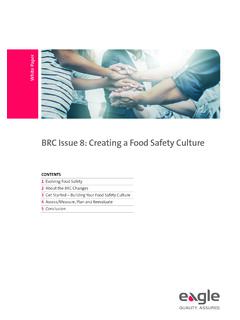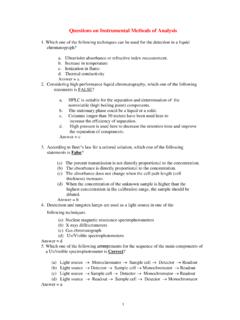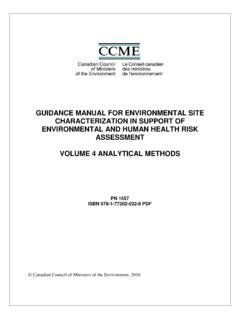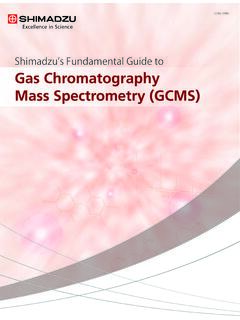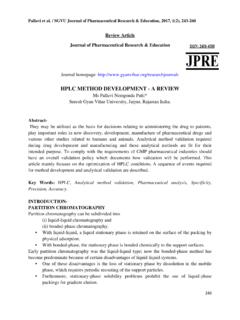Transcription of Cleaning Validation for Medical Device Manufacturing
1 Cleaning Validation for Medical Device Manufacturing | Alconox, Inc. 1 Critical Cleaning ExpertsSMCleaning Validation or verifi cation is a necessary regulatory compliance step in Medical Device Manufacturing and reprocessing. Support from the cleaner manufacturer can save time and money when establishing either Cleaning Validation or Cleaning verifi cation processes. This white paper outlines the basics of Cleaning Validation and how the cleaner manufacturer can help simplify and speed up the process, as well as support ongoing maintenance of the validated or verifi ed CRITICAL Cleaning : A WHITE Is Cleaning Validation ?
2 Cleaning Validation is documentation establishing that a Cleaning process will consistently result in devices that are clean to a predetermined acceptable level of cleanliness. In the Medical Device Manufacturing industry, Cleaning Validation is generally performed by examining the fi nished Device itself rather than the equipment used to manufacture it. In addition to Cleaning Validation , sterility Validation is required for products sold sterile. Although sterility Validation is beyond the scope of this paper, Cleaning Validation is important for any Device sold sterile.
3 (For more information about sterility Validation , contact Alconox, Inc.) Validation concerns vary across the industry and depend on the class of Medical Device . devices are classifi ed according to the nature of patient contact. Re-usable examining devices with incidental patient contact might be tested for function and, possibly, bioburden. Implantable Medical devices with years of internal patient contact might also be tested for endotoxins, cytotoxicity, sterility, and proper Device function. The goal of Validation is to prove that a system is functioning properly within established parameters to ensure product, patient, worker, and environmental safety.
4 To achieve this, manufacturers typically have a Validation committee with clearly defi ned Cleaning Validation for Medical Device ManufacturingWhy Get Cleaning Validation Support From Your Cleaner Supplier? Medical Device ManufacturingWhat Is CleaningValidation? 1 Defi nitionsProduction and Process Controls Inspection,Measuring, and Test Equipment2 Process Validation 3 Validating the Use of a Cleaner Identifying Cleaner Residues Selecting and Validating a Residue Detection Method4 Choosing a Sampling Method Constructing Recovery StudiesSetting Residue Acceptance Criteria 6 Using Total Organic Carbon to Measure Residue Acceptance Criteria 9 Writing Procedures and Training OperatorsFinal ValidationReportCleaning SupplierValidation Support 10 Get Validation Support 11 Cleaning Validation for Medical Device Manufacturing |
5 Alconox, Inc. 2responsibilities, consisting of these members: Validation Specialist Writes andcoordinates the procedure Manufacturing Writes SOPs and providestraining Quality Assurance/Control Approvesand implements analytical methods Engineering Communicates changes andevaluates equipment data R&D Performs recovery studies, validatesand transfers methods, and selects newcleanersThe required Cleaning Validation documentation is specified in the relevant sections of the manufacturer s Validation Master Plan, including: The objective Background Equipment/reagents Responsibilities Product Procedures Residue acceptance limits, with rationale Analytical methods Sampling procedures and recovery Cleaning process design Data analysis Assumptions Change control/maintenance References All Cleaning Validation documents are subject to an FDA inspection process known as the Quality System Inspection Technique (QSIT), defined in the FDA Guide to Inspections of Quality Systems (FDA Center for devices and Radiological Health [CDRH], August 1999).
6 QSIT establishes a top-down approach for inspecting and managing these subsystems of a firm s overall quality system: Corrective and Preventive Actions Management Controls Production and Process Controls Facility and Equipment Controls Records, Documents and Change Controls Material Controls Design ControlsThese subsystems must conform to current good Manufacturing practice (cGMP) in accordance with the Quality System regulations (21 CFR Part 820). The ISO Medical Device quality equivalent is ISO 13485. The most relevant sections to critical Cleaning and Cleaning Validation are listed below.
7 Definitions(p) Manufacturing material means any materialor substance used in or used to facilitatethe Manufacturing process, a concomitantconstituent, or a byproduct constituent producedduring the Manufacturing process, whichis present in or on the finished Device as aresidue or impurity not by design or intent of themanufacturer. Production and process controls(ISO 13485:2003 + + + + + )(e) Contamination control. Each manufacturer shallestablish and maintain procedures to preventcontamination of equipment or product bysubstances that could reasonably be expected tohave an adverse effect on product quality.
8 (h) Manufacturing material. Where a manufacturingmaterial could reasonably be expected tohave an adverse effect on product quality, themanufacturer shall establish and maintainprocedures for the use and removal of suchmanufacturing material to ensure that it isremoved or limited to an amount that does notadversely affect the Device s quality. The removalor reduction of such Manufacturing material shallbe documented. Inspection, measuring, and testequipment(ISO 13485:2003 )(a) Control of inspection, measuring, and testequipment. Each manufacturer shall ensure thatall inspection, measuring, and test equipment,including mechanical, automated, or electronicinspection and test equipment, is suitablefor its intended purposes and is capable ofproducing valid results.
9 Each manufacturer shallestablish and maintain procedures to ensurethat equipment is routinely calibrated, inspected,checked, and maintained. The procedures shallBefore: Blood dried onto scalpel handles is difficult to thoroughly : Soaking in TERGAZYME, followed by gentle Cleaning , prepares surgical instruments for effective sterilization and prolongs instrument Validation for Medical Device Manufacturing | Alconox, Inc. 3include provisions for handling, preservation, and storage of equipment, so that its accuracy and fitness for use are maintained. These activities shall be documented.
10 Process Validation (ISO 13485:2003 + + + + + )(a) Where the results of a process cannot be fullyverified by subsequent inspection and test, theprocess shall be validated with a high degree ofassurance and approved according to establishedprocedures. The Validation activities andresults, including the date and signature of theindividual(s) approving the Validation and whereappropriate the major equipment validated, shallbe , the FDA has been supporting arisk-based approach for Medical Device process validations. These types of risk-based approaches would include something like a pFMEA (process failure mode engineering analysis).



